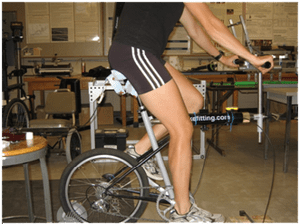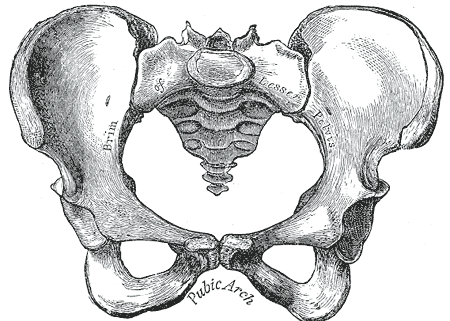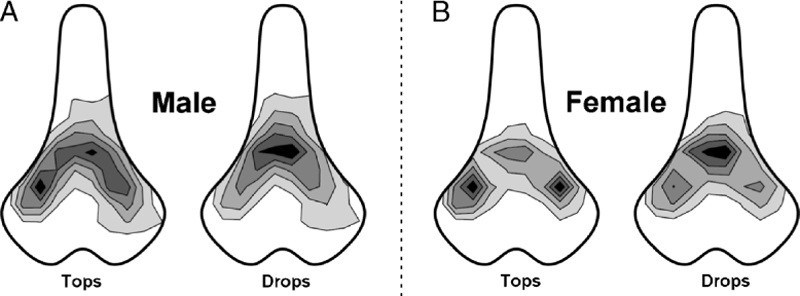What Makes a Comfortable Bike Seat?
How We Set Out to Achieve Bike Seat Comfort:

This study of bike seat comfort has been long debated, however no long term studies of a large group size haver been conducted. But really, it doesn’t take a rocket scientist to know that numbness means blood is being constricted. Women often have numbness in their legs, men get “Numb Nuts”.
To combat blood constriction, The RideOut seat disperses rider weight over a great area and actually flexes with the riders’ movements. A slight flexing of the seat (1/8 to ¼ of an inch) is enough to relieve pressure. Studies conducted by the University of Wisconsin, Madison, Bioengineering department visually demonstrate the difference in seat pressure.
Both photos were produced by placing a pressure mat between the rider and two different seats (see photo above). Bike, seat angle, rider and rider placement were exactly the same between the two tests, the only difference being the seat. These photos are of a 144 lb. male. The test results are below:


The scale on these graphics runs from 0 to 80 pounds per square inch. In this case, less pressure is much, much better!
(See also the Science Behind a Comfortable Bike Seat page for moving videos of a 190 lb. man riding a Stella seat and a Carbon Comfort.)
What Makes a Comfortable Bike Seat?
Sheldon Brown (1) points out that a saddle is meant to support some of your weight whereas a seat is meant to support most of your weight. If you are a recreational, commuter, or less than 50 miles a week rider, and uncomfortable, consider a “seat”. Another thing to consider is, if your handle bar height is equal to or higher than the height of the seat, you probably should be looking for a “seat”.
Riders have been told they have to toughen up their behinds or “get calluses”. New research shows this is not true. That in this case, pain is bad. Pain and numbness can lead to a 30% chance in increased erectile dysfunction
“…when the patient straddles a traditional narrow saddle, there is no blood flow to the penis.” (2)
– Dr. Irwin Goldstein

This shows a diagram of a pelvis. Thin narrow saddles sit in the pubic arch and for many people this causes chaffing and pain.

The diagrams were produced by the U of W showing the average pressure riders experience in different positions. The darker the area, the more the pressure. RideOut seats are designed to support the rider on the actual ischial tuberosities, also known as “sit bones” and shown in the diagram and the bottom of the ischium.
Some bike seat designers suggest that simply getting rid the horn would solve the problems, but horns serve the most useful purpose of weight transfer especially while turning. See editor Mike Deme’s report in the ADVENTURE CYCLIST MAGAZINE, Geared UP, March 2012 for greater explanation. (3)
Our bodies are designed to “sit” on our “sit bones” or ischial tuberosities of our pelvic structure. The wider base and narrower horn of the Carbon Comfort design disperse rider’s weight better than other seats on the market and University testing proves this. (4)
Hard, Soft, Gel- which is most comfortable?
Hard seats are, well… hard. When our tissues are compressed, blood flow is restricted. This leads to numbness and after riding, swelling. Just consider, you would rather sit on a wooden bench or a padded bench?
Soft seats present their own issues. The greater the padding, the greater the amount of body heat the seat itself can hold. The warmer the tissues are the more blood is needed to cool the tissues. Bio mechanical research shows that the greatest comfort comes from least amount of body to device contact. This translates as, while padding can be more comfortable, we want that to be as small amount of padding as possible. (5)
Gel Seats and Gel pads are just another option in padding, gel can however hold body heat even more than foam and simple spread the pressure around rather than support. As a sport professional stated. “If you had an uncomfortable shoe, you wouldn’t put on a thicker sock, you would find a shoe that fits your foot. And a bad design padded – is just another bad design.” (6)
Bike Fit and Comfort
All bikes should be fit to the rider and Jim Langley (7) does a good job of explaining bike fit on his site. Note however, this is for saddle fit whereas a bicycle seat is equal to or lower than the height of the handle bars and refer to our page for fitting bicycle seats for a visual demonstration on getting maximum bike seat comfort from any bicycle seat.
The skinny of why we should ride bikes:
I have always believed that if we could make a more comfortable bike seat, we could change the world. The most common complaint among riders and non-riders is bike seat discomfort. (8) The average car trip in the US is less than 5 miles, imagine the difference, politically, economically, environmentally and personally to our waist lines, it would make if we just rode those miles on a bike and not in a car. Well, I am doing that. I am a woman in my mid 50’s who decided to change my life, follow my ideas and invent simply the comfortable bike seat there is.
There has been nothing easy about this journey, but it is one I believe in. It was on a long cross-state ride that I became so sore from riding I ended up pushing my bike down a seemingly endless highway. After trying a full range of existing seats and realizing a design change was needed. I knew there had to be something better. So I went to work to build it. I also know there is nothing more empowering than being fit and healthy.
For more bike seat comfort science and to watch videos of the study and pressure maps see the Science Behind a Comfortable Bike Seat page here.
Sources
1. http://sheldonbrown.com/saddles.html
2. Boston University Institute of Sexual Medicine by Irwin Goldstein M.D., Ricardo Munarriz M.D., Scott Maitland M.D., Terry Payton R.N.
3. ADVENTURE CYCLIST MAGAZINE, Geared UP, March 2012 By Mike Deme, Editor, Adventure Cyclist editor@adventurecycling.org
4. Med Sci Sports Exerc. 2008 Jun;40(6):1126-34. doi: 10.1249/MSS.0b013e3181666eea.
Gender differences in bicycle saddle pressure distribution during seated cycling.
Potter JJ, Sauer JL, Weisshaar CL, Thelen DG, Ploeg HL.
Departments of Biomedical Engineering, University of Wisconsin-Madison
5. Journal of Biomechanical Engineering
6. Larry M. Hill, outdoor sport professional
